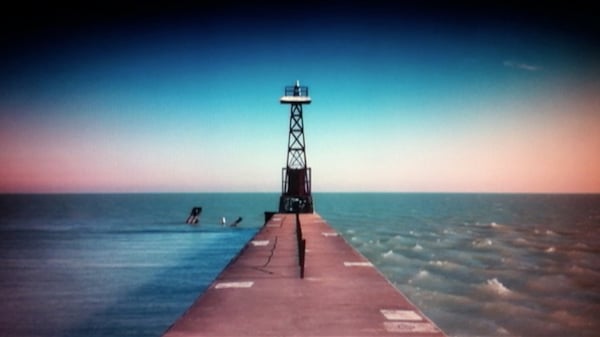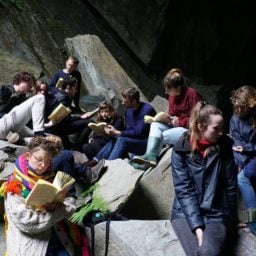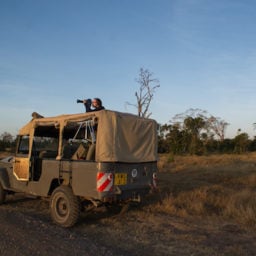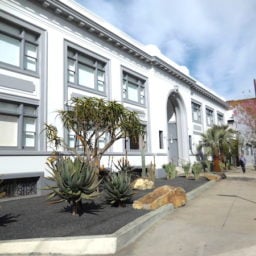Nestled in the rolling Somerset hills amid the miscellany of converted barns and outbuildings of Hauser & Wirth Somerset is “Qwaypurlake,” a group show curated by Simon Morrissey. Though nestled is not quite the right word. Because, although the show responds directly to its setting, seeming quite at home amid the exposed roof trusses and bare sandstone walls, “Qwaypurlake” is intent on building an atmosphere of increasing disquiet rather than comfort.
The works’ largely somber palette also appear to spill from the hues of the gallery architecture. Natural materials with earthy associations predominate: stone, wood, and bronze. Oversized and unidentifiable bronze heads (with fish-like qualities) and mutated birds by Elisabeth Frink are set on plinths alongside black stoneware in individual vitrines by Hans Coper, and a sprinkling of Marie Toseland’s own wisdom teeth, partially chipped. These appear like items of evolutionary, historic, or anthropologic interest: the remains of animal life, relics of a defunct species and their bodily remnants. This world is bleak, one in which humans figure only at a distant remove.
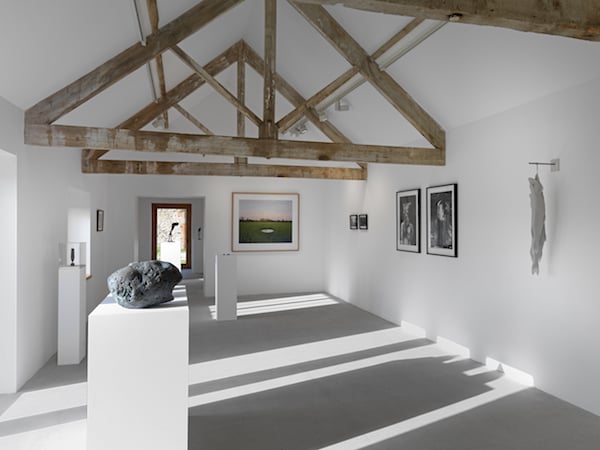
Installation view of “Qwaypurlake” at Hauser & Wirth Somerset.
Photo: Ken Adlard Courtesy the artists and Hauser & Wirth.
If it wasn’t already clear, “Qwaypurlake” isn’t a show stopper. Instead, it takes an interestingly long form approach to curation, its narrative themes slowly unfurling as you pass through the four gallery rooms. There’s a meditative, even mournful, approach to it, which feels unusual in the context of a commercial gallery. It compares to long-form fiction, but not the kind of book that you pick up and can’t put down again. The exhibition’s pace grows steadily by degrees.
The show calls to be retold in narrative order. The scene is prefaced by David Wojtowycz’s The Lake (2012), a large scale filmed projection of a simmering waterscape split in two by a breakwater. This work is key, functioning like a “through the looking glass” narrative device. It foregrounds the fiction to follow with its heavily saturated blues and reds, rung around with strong vignetting. As the video hovers in mid air, partially blocking our entry into the rest of the show, we are forced quite literally to go behind it, as if entering its world. What follows, is like the drained fallout from Wojtowycz’s flood.
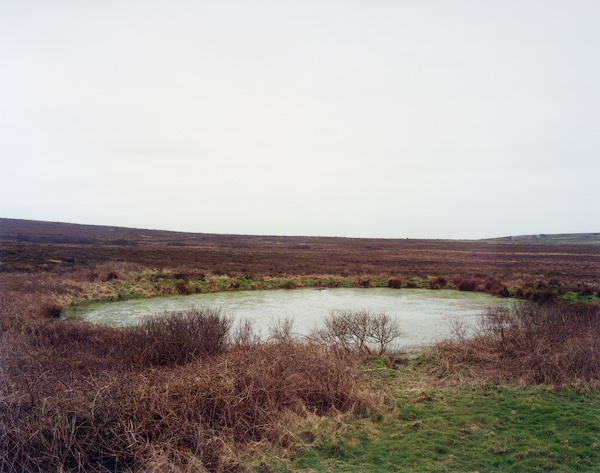
Jem Southam, Woongumpus, Penrith Moors, Cornwall.
Photo: © Jem Southam
Courtesy Hauser & Wirth and the artist.
The next two small rooms present mainly chromatically restrained photographs and sculptures. In the first of these rooms is Pike (2007), by Daphne Wright, a white marble dust cast of two dead fish strung up. These dangle beside Ben Rivers’s Somerset Clade series (2010) of black and white images of human torsos, masked with horror movie-style hessian sacks.
This room is followed by another which smacks even more strongly of elemental West Country myth—with traces of earth, fire, and water, though thankfully no crystals. James Ravilious’s unpeopled photographs of small woodland scenes share the room with Jem Southam’s desolate images of almost perfect circles, dew ponds like mirrors, set into the landscape. And work from Aaron Schuman’s Summer Set of ashes and smoke provide further evidence of a world that was.
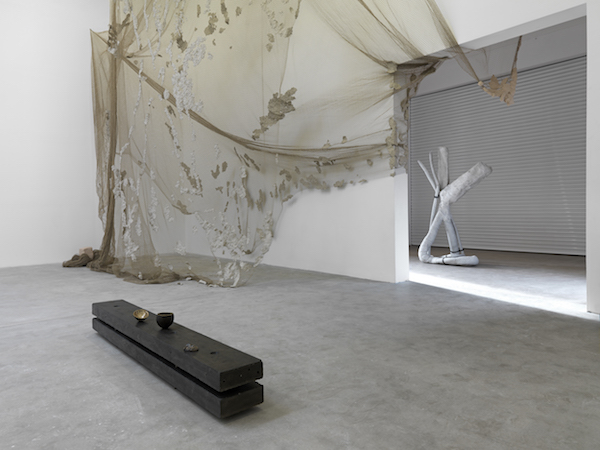
Installation view of “Qwaypurlake” at Hauser & Wirth Somerset.
Photo: Ken Adlard Courtesy the artists and Hauser & Wirth.
Things come to a climax in the show’s final and largest room. Sebastian Jefford’s huge net, Wattle and Daub (2015), is draped across part of the room’s entrance and along one wall. It is clogged with patches of beige plasticine, rather than fish, and conjures perished ocean life. A few paces away water drips from the ceiling into what appears to be one half of a bronze coconut. This is part of a series of eerie still lifes by Heather & Ivan Morison, in which forms made from materials ranging from bronze to animal fat, from wax to mud, sit atop low-lying, singed-looking, wooden planks.
At centre stage is Wright’s white marble dust sculpture Stallion (2009), an exquisitely crafted partially flayed life-sized horse frozen in writhing agony. It lies supine before a backdrop of three vast, mainly black Ian McKeever paintings (2009–2011). The surfaces of this triptych are a wonder, appearing both texturally slight, but also molten, rich, and oppressive, as if charred in vertical waves.
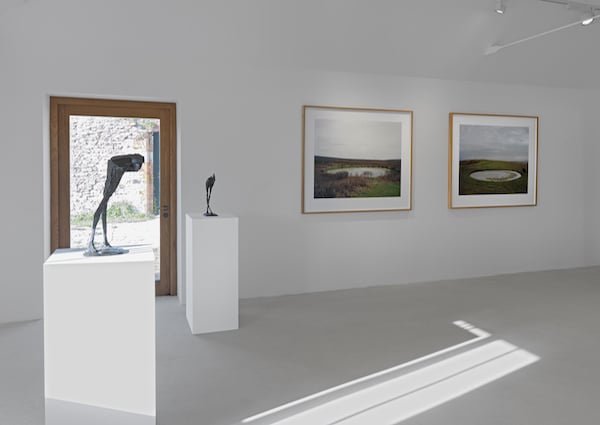
Installation view of “Qwaypurlake” at Hauser & Wirth Somerset.
Photo: Ken Adlard Courtesy the artists and Hauser & Wirth.
Until this moment of drama, there’s a slow burning and unabashed obscurity at play in “Qwaypurlake.” And its fantastically impressionistic accompanying publication of poetic snippets—written by some of the artists alongside Morrissey—sheds little light on it. The show’s erudition might well be a turn off for those after a quick art fix, but there’s so much to savour here, given the time.
It is an esoteric collision of landscape history, myth making, science fiction, and etymology. It has the feel of an exhibition of curios—found, made, sounded, salvaged, or preserved—that document the aftermath of a calamity yet to strike: a volcanic eruption, a forest fire, a flood, or some other cataclysmic natural or unnatural disaster. “Qwaypurlake” is a challenge, one that many galleries would shy away from. But it calls for a sequel.
“Qwaypurlake” is on view at Hauser & Wirth Somerset, from November 15, 2015 – January 31, 2016.
Follow Artnet News on Facebook:
Want to stay ahead of the art world? Subscribe to our newsletter to get the breaking news, eye-opening interviews, and incisive critical takes that drive the conversation forward.
